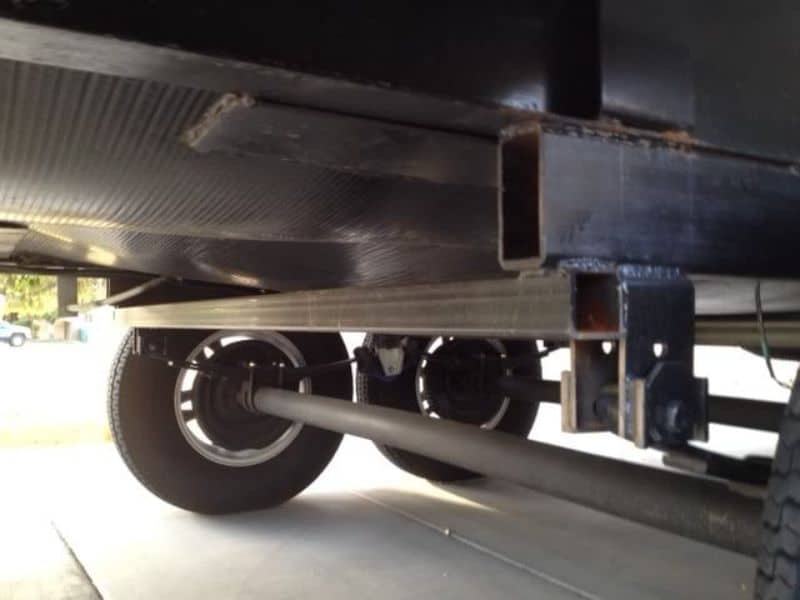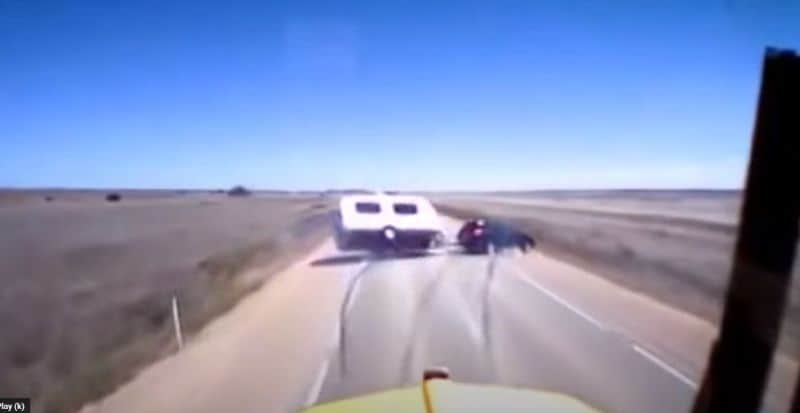“Flipping the axle” is a colloquial way of saying “lifting my RV.” It’s an aftermarket procedure used to gain ground clearance. There are a lot of misconceptions about this procedure, the biggest of which is that you actually flip the axle. Don’t do that.
Let’s run through the pros and cons of flipping your axles, and whether you really need it to improve ground clearance.
What Is Flipping a Trailer Axle?
To clear up a common misconception, you don’t actually flip the axle. You’re not turning the axle upside down or anything like that. If you’ve read my quick tip on tire care, then you know that an axle is built with camber, and it is intentionally bowed upward. So the axle stays in the same orientation; you’re just re-installing the axle tube below the leaf springs to gain 4-6 inches of ground clearance.
The phrase “flipping the axle” is usually applied to leaf spring suspensions.
- The standard method for attaching leaf springs is underslung, where the leaf springs run below the axle tube.
- The alternative method is called overslung, where the leaf springs sit on top of the axle tube. That’s what happens when you have the axle “flipped.”

“Flipping an axle” usually means going from an underslung to an overslung configuration. You will gain ground clearance equal to the thickness of the axle tube, the leaf springs, and the spring seats, usually 4-6 inches total.
Torsion axles can’t be flipped. However, both Dexter and Lippert offer torsion axle lift kits with spacer blocks. These spacer blocks are bolted between the axle brackets and the mounting hangers and will raise the RV by 2-4 inches. You can also order a replacement torsion axle with high-profile spring seats, which add an extra 1” of clearance.
Public Service Announcement: There are some people, even trailer shops, that actually think flipping an axle literally means installing it upside down! If you come across one of these shops, like this poor RV owner here, make like a banana and split!
Other Options Besides Flipping the Axle
If you’re hunting for extra ground clearance, there are options besides flipping an axle.
- If you have a leaf spring suspension, you can add a leaf, change the shackles, or re-weld new spring hangers. These are all changes that must be performed by a skilled mechanic.
- If you have a torsion axle, you can install simple bolt-on spacer blocks, as I mentioned above.
- If there’s room in the wheel wells, you can install a larger tire with a bigger diameter.
- Some RVs can be raised by inserting and welding structural steel tube between the frame main rails and the axle hangers (which also better distributes the load from the axle hangers to the chassis). This fundamentally changes the chassis design, however, and so it’s not something I can recommend carte blanche.
- If you have the opposite problem and are wishing to lose ground clearance, you might need a drop axle.
Advantages of Flipping a Trailer Axle

9 times out of 10, when someone wants to flip an RV axle, it’s because they want extra body ground clearance.
- When you want to navigate rough roads while boondocking and dry camping, the extra ground clearance can help you clear ruts, humps, potholes, and breaks.
- If you have a low-clearance trailer, the extra ground clearance can protect your tanks, sewer valves, jacks, and other underbelly equipment from road damage.
- If you own a large pickup truck, the extra ground clearance may keep your trailer coupler better aligned with the pickup truck without the need for a drop ball mount.
Will Flipping an Axle Improve My Ground Clearance?
First of all, you should know that flipping an axle from overslung to underslung doesn’t really change the clearance from the ground to the axle tube. So you can’t go driving over larger speed bumps or big boulders.
However, flipping the axle does change the body ground clearance, that is, the clearance from the ground to the RV body and frame. This will improve your departure, approach, and break-over angles. If you find yourself often scraping the bumper, extra body ground clearance will often solve that problem.
Disadvantages of Flipping a Trailer Axle
- The entry steps will be higher. 4-6 inches might not sound like much, but consider that the average step height is about 7 inches. You’ll probably need a new entry step after flipping the axles.
- Jacks need a longer reach. You might unpleasantly discover that your stabilizer jacks or tongue jack doesn’t reach the ground without a Leaning Tower of Pisa stackable blocks beneath each one.
- Toy haulers will have a steeper ramp. Can your toy still drive into the garage at a steeper angle?
- You might be too tall for overpasses and garages. Have you considered the effect of the extra height on storage options or traveling? Garage doors typically come in 10’, 12’, and 14’ height – will the extra ground clearance push you above a standard size? If you’re towing a big tow hauler or 5th wheel, will you be taller than the legal limit in your area (usually 13- to 13.5-feet)?
- You might lose visibility. If you’re towing a teardrop, pop-up, expedition, or other miniature travel trailer, then raising the camper might kill your rearward visibility.
- You might need to reinforce your suspension. Flipping an axle generally extends the “lever arm” from the spring hanger to the axle centerline. That puts more stress on the spring hangers, which are welded to your frame. They may need to be reinforced with V-braces or gussets.
- You might lose fuel economy. A taller RV will catch more of the wind, which will further decrease your fuel economy. It’s not likely a major hit, but every mpg counts!
- You might increase trailer sway. This concern is so important I wrote an entire section on it. Just keep reading …
Will Flipping the Axle Increase Trailer Sway?

When you install a lift kit or flip the axles, you’re raising the center of gravity. Pretty much any vehicle dynamics engineer will tell you that raising a vehicle’s COG is the worst thing you can do for vehicle handling. So yes, it has a negative impact, generally making the trailer more prone to sway, yaw, and roll. The taller position will also expose more of the RV sidewall to crosswinds, which can further induce trailer sway.
Will the deterioration in handling be noticeable? Eh, I can’t answer that for you. It really depends on the RV. But I can give you some rules of thumb. The narrower an RV compared to its width, and the closer an RV to its GVWR, the more noticeable the detriment will become. So the trailer sway problem is worse on 5th wheels, toy haulers, and mega-sized travel trailers. Essentially, if your RV is prone to sway now, it will only get worse. If you want to know more about the physics of underslung vs overslung axles, I invite you to check out an excellent article on the subject at MechanicalElements.com.
So short answer, yes, flipping the axle will increase the risk of trailer sway. Whether it will have a significant real-life detraction is unknown. Ask the RV manufacturer, and seek feedback from other RVers with similar rigs who have gone before.
How to Flip an RV Trailer Axle (not DIY!)
Don’t try to flip an axle yourself! That’s a good way to get squashed flat like a bug. The trailer has to be completely supported by the frame for the axle to be removed, and the stabilizer jacks should NEVER be used for this purpose.
Both straight, drop axles and tandem axles can be “flipped” to an overslung configuration.
The actual “flipping” of the axle is relatively straightforward for a professional mechanic. Common mistakes include reusing the old hardware and cutting off the old spring seats. As Reg DeYoung writes for RVWest, “Another issue for do-it-yourself folks is using a torch to cut the existing axle saddles or spring perches off with an acetylene torch to be used for the new axle position. If the axle tube is burnt through the integrity of the axle will be compromised. Lastly, you should never use the existing U-bolts to complete an axle flip. It is advisable to put new U-bolts and torque to the manufacturer-specified torque settings.”
All axle manufacturers also provide over-under conversion kits. Don’t trust someone who wants to cut off the old hardware and re-weld it somewhere else. Purchase the conversion kits and have your mechanic follow the instructions to the letter.
For more enjoyment, I leave you with this video on how to install a Dexter over/under conversion kit:
Leave a Reply